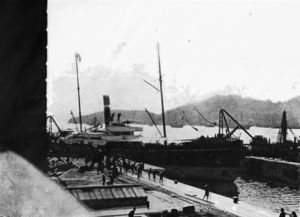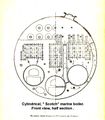Sungkiang
Contents
History
Note:- This class of vessels had a single luffing derrick in front of the bridge, which was hand worked and used to manoeuver bales etc. in or out of barges and junks such as at Taku bar. CNCo's coastal cargo/passenger ships had a curved cutwater. The vessels, in common with most ships of this era, carried Chinese deck passengers in the 'tween decks, and were equipped with five lifeboats and a working dinghy. Boiler feed water was carried in double bottom tanks below the engine room and in the forepeak. No double bottom tanks were constructed below the cargo holds, hence if the vessel was holed, the hold became flooded. Potable water was contained in two built-in tanks, one in number one lower hold and the other in number three 'tween deck, hence drinking water would be in short supply when carrying a full load of passengers. The donkey boiler was situated on the main deck aft of the funnel.
The Master's cabin was on the boat deck, and attached to it was the chartroom which was used as a store for clean charts (only used by the master),flags, soumding leads, a spare compass and a barometer. The single chronometer was kept in the Master's cabin and checked against the observatory time-ball in Shanghai and Hong Kong or in out-ports with ship with a wireless. The accommodation for two mates and the three engineers was on the starboard side of the centrecastle, the stewards ad compradores being on the port side. The tallymen and hatchmen were in the poop structure. The forecastle was half above and half below the main deck, and here the deck and engine room crew members lived.
At this time Scott's shipyard used 2.5 inches (63.5 mm) thick teak for the decks and handrails for many of the China Navigation Co. vessels, this was a more demanding timber to work, however Alfred Holt's "Blue Funnel" vessels used the cheaper and easier worked Oregon Pine.
August 10th. 1908. The Sungkiang became the first vessel to use the new Taikoo Dockyard, which was built after the death of John Samuel Swire (senior) who always opposed the building of the dockyard.
August 21st. 1918. Became holed when went aground on Boat Rocks, 30 miles from Swatow. Attempted to make for Swatow, but was abandoned near Lamock Island where she sank.
Service
Built for the China coast trade. The Sungkiang was the first of a series of 18 ships built by Scotts' Dockyard and Engineering of Greenock, affectionately known as "beancakers". The other "beancakers" were the Kaifong, Singan, Yunnan I , Kweiyang I, Nanchang I, Chihli, Kashing, Szechuen I, Kweilin I, Paoting, Hunan I, Kalgan I, Kansu, Foochow II, Pakhoi II, Tientsin II, and Wuhu II.
Soya beans were grown in Manchuria and the lucrative trade was in the transportation of soya bean, bean oil and the beancake from Yingkou (Nanchang) to Shantow and Xiamen (Amoy) in southern China. The beancake being used as a fertiliser. Beancakes were the residue left after pressing oil from soya beans, the cakes being about two and a half feet (76 cm.) in diameter and about three inches thick (75 mm.). The bean cakes being loaded by rolling them through side ports. Sugar from Taikoo Sugar refinery in Hong Kong was a north bound cargo, a stop being made at Shanghai to take on the coal for the ship's bunkers.
The beancake trade declined after WW1 by the introduction into the southern part of China of chemical fertiliser from Germany.
Events / Stories
Graham Torrible in his book Yangtze Reminiscenses noted that the beancakers figured prominently in first promotions and also, alas, as punishment ships. "As a punishment for drink, a popular and indeed one might say, the only, crime in those days, it was more a slippery slope to resignation than a cure. The life indeed was a lonely one." The beancakers never had wireless and therefore were a good school for learning the "Law Of Storms" in relation to the avoidance of typhoons. They were also a good school for learning what was called "rock-dodging" on the China Coast.



